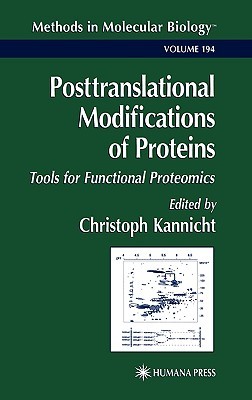
- We will send in 10–14 business days.
- Publisher: Humana
- ISBN-10: 0896036782
- ISBN-13: 9780896036789
- Format: 16.9 x 23.7 x 2.6 cm, hardcover
- Language: English
- SAVE -10% with code: EXTRA
Posttranslational Modification of Proteins (e-book) (used book) | bookbook.eu
Reviews
Description
Posttranslational Modifications of Proteins: Tools for Functional Proteomics is a compilation of detailed protocols needed to detect and analyze the most important co- and posttranslational modifications of proteins. Though, for reasons of simplicity not explicitly mentioned in the title, both kinds of modifications are covered, whether they occur during, or after, biosynthesis of the protein. My intention was to cover the most significant protein modifications, focusing on the fields of protein function, proteome research, and the characterization of pharmaceutical proteins. The majority of all proteins undergo co- and/or posttranslational modifications. Knowledge of these modifications is extremely important, since they may alter physical and chemical properties, folding, conformation distribution, stability, act- ity, and, consequently, function of the proteins. Moreover, the modification itself can act as an added functional group. Examples of the biological effects of protein mo- fications include: phosphorylation for signal transduction, ubiquitination for p- teolysis, attachment of fatty acids for membrane anchoring or association, glycosylation for protein half-life, targeting, cell-cell and cell-matrix interactions, and carboxylation in protein-ligand binding to name just a few. Full understanding of a specific protein structure-function relationship requires detailed information not only on its amino acid sequence, which is determined by the corresponding DNA sequence, but also on the presence and structure of protein modifications.
EXTRA 10 % discount with code: EXTRA
The promotion ends in 19d.03:27:39
The discount code is valid when purchasing from 10 €. Discounts do not stack.
- Publisher: Humana
- ISBN-10: 0896036782
- ISBN-13: 9780896036789
- Format: 16.9 x 23.7 x 2.6 cm, hardcover
- Language: English English
Posttranslational Modifications of Proteins: Tools for Functional Proteomics is a compilation of detailed protocols needed to detect and analyze the most important co- and posttranslational modifications of proteins. Though, for reasons of simplicity not explicitly mentioned in the title, both kinds of modifications are covered, whether they occur during, or after, biosynthesis of the protein. My intention was to cover the most significant protein modifications, focusing on the fields of protein function, proteome research, and the characterization of pharmaceutical proteins. The majority of all proteins undergo co- and/or posttranslational modifications. Knowledge of these modifications is extremely important, since they may alter physical and chemical properties, folding, conformation distribution, stability, act- ity, and, consequently, function of the proteins. Moreover, the modification itself can act as an added functional group. Examples of the biological effects of protein mo- fications include: phosphorylation for signal transduction, ubiquitination for p- teolysis, attachment of fatty acids for membrane anchoring or association, glycosylation for protein half-life, targeting, cell-cell and cell-matrix interactions, and carboxylation in protein-ligand binding to name just a few. Full understanding of a specific protein structure-function relationship requires detailed information not only on its amino acid sequence, which is determined by the corresponding DNA sequence, but also on the presence and structure of protein modifications.


Reviews